Ideal working distances vary by lens type: iD Zoom lenses perform best at 4-6 feet, while iD Screen lenses work well at 10-12 feet. For microscopy, low-power objectives need 12mm spacing, while high-power lenses require just 0.2mm. Your working distance directly impacts image clarity, depth of field, and comfort. Consider your specific application—whether desk work, precision tasks, or specimen viewing—as each demands different spacing for peak performance. These distance guidelines will transform your optical results.
10 Best Working Distances for Clear Lens Performance
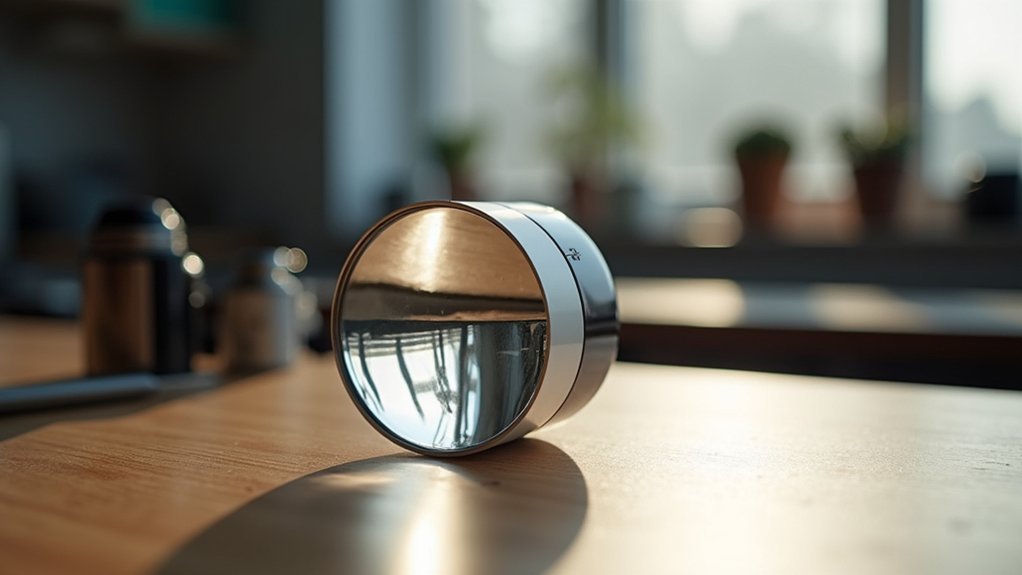
When selecting the ideal lens for your visual needs, understanding the relationship between working distance and lens design becomes essential. Different lenses are tailored for specific focal lengths, which directly impacts your visual comfort and productivity.
For close-range tasks at 4-6 feet, the iD Zoom lens offers peak performance with a maximum working distance of 8 feet. If you frequently collaborate in larger spaces, consider the iD Screen lens, which accommodates both desk work and viewing at 10-12 feet.
Indoor-specific multi-focal lenses enhance your ergonomics for objects closer than 20 feet, providing a wider field of view and minimizing head movement.
Optimal Working Distance for Standard Microscope Objectives
Microscope objectives operate within much more precise working distances than everyday lenses.
You’ll need to maintain specific distances between your objective lens and specimen to achieve ideal clarity and prevent damage.
- Low-power objectives (10x) provide comfortable working distances around 12mm
- High-power objectives require minimal spacing, often just 0.2mm
- Oil immersion objectives (100x) need ultra-precise 0.2mm working distance
Proper spacing prevents accidental contact that could damage both lens and specimen.
Maintaining precise objective-to-specimen distances protects your equipment investment while ensuring optimal microscopic visualization.
Calibrated working distance guarantees sharp focus and clear imaging.
Understanding these parameters helps you manipulate specimens effectively while maintaining focus.
When you’re switching between objectives, remember that higher magnifications demand shorter working distances.
Precise calibration of this space between your objective lens and slide is crucial—improper distances will result in blurry images or potential equipment damage.
Long Working Distance Objectives and Their Applications
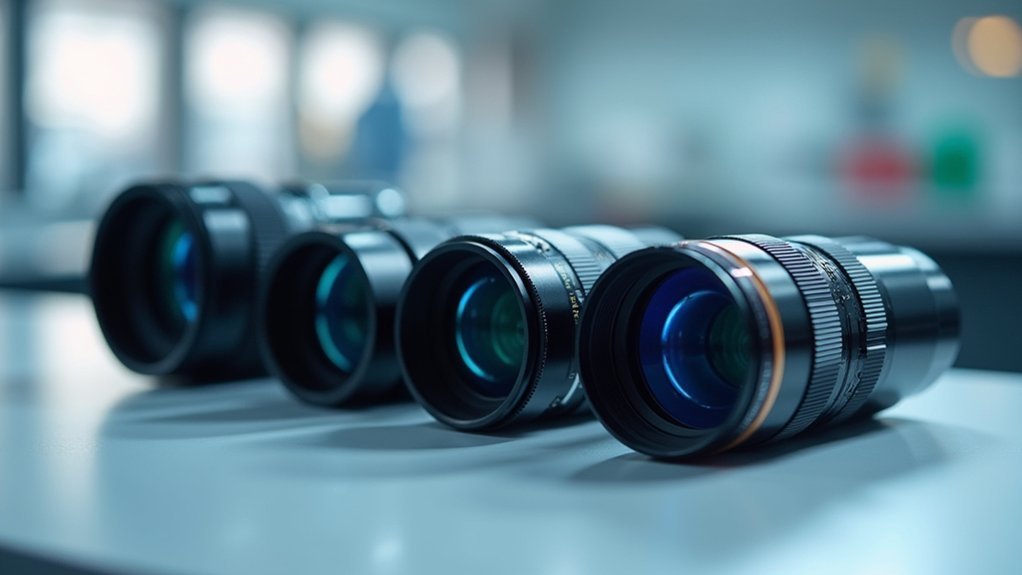
Unlike standard objectives, long working distance (LWD) objectives provide exceptional clearance between the lens and specimen, typically ranging from 8-30mm.
You’ll find these specialized lenses particularly valuable for applications beyond traditional microscopy, including long-range imaging at distances exceeding 20 feet.
When using LWD objectives, you’ll benefit from an expanded field of view, reducing the need for frequent head movements while observing distant subjects.
This design promotes natural posture, essential when you’re engaged in extended viewing sessions.
For peak performance, verify your main viewing and working distances are properly matched.
This alignment minimizes adaptation issues and maximizes image clarity.
Many LWD objectives feature advanced coatings that enhance light transmission and reduce distortion, delivering superior image quality even at considerable distances.
Working Distance Trade-Offs With Magnification Power
When you’re choosing a lens for your photography needs, you’ll encounter an unavoidable inverse relationship between magnification power and working distance.
Your field of view narrows considerably as magnification increases, requiring careful consideration of composition and subject size in tight working spaces.
Higher magnification setups will also limit your available light, often necessitating additional lighting solutions when you’re working at close focusing distances.
Inverse Magnification Relationship
The fundamental physics governing lens performance creates an unavoidable trade-off that affects every lens user: as magnification power increases, working distance decreases proportionally. This inverse relationship directly impacts your ability to perform tasks requiring specific viewing distances.
When selecting a lens, consider how this relationship manifests:
- A 10x magnification lens might position you just centimeters from your subject.
- Professional microscopy work requires extremely short working distances for high clarity.
- Reading glasses with lower magnification power allow comfortable document distance.
- Precision tasks like watch repair demand higher magnification but force closer proximity.
- Distance viewing applications need reduced magnification to maintain practical working distances.
Understanding this fundamental constraint helps you choose appropriate lenses for your specific needs, avoiding the frustration of insufficient working distance when high magnification is unnecessarily selected.
Field Width Considerations
Field width represents another significant dimension of lens performance that’s intertwined with working distance. When you choose a lens with a longer working distance, you’ll typically experience a narrower field of view, requiring more head movement to see everything in your visual field.
Higher magnification lenses usually come with shorter working distances, which directly impacts your field width and can compromise your viewing posture. For instance, if you’re using a lens designed for 4-6 feet viewing, its maximum working distance might only reach about 8 feet, potentially limiting your visual range during broader tasks.
To optimize your experience, you’ll need to carefully balance these factors. Understanding the relationship between working distance and field width guarantees you’ll select a lens that supports your specific visual needs without requiring excessive adaptation.
Light Gathering Limitations
Light gathering capability presents a fundamental trade-off that directly affects your clear lens performance. As you increase magnification, your working distance shrinks, forcing you closer to your subject and limiting available light. This inverse relationship creates practical challenges for capturing well-lit, sharp images.
- Your high-magnification macro lens with a 2cm working distance casts shadows on delicate flower stamens.
- Light struggles to reach your subject when your lens hovers just millimeters away.
- Wide apertures compensate for limited light but create razor-thin depth of field.
- Your carefully positioned external light sources become obstructed by the lens itself.
- Background elements fade into darkness as working distance decreases.
Understanding these light gathering constraints helps you select ideal working distances for your specific photography needs, balancing magnification power with adequate illumination.
Measuring and Maximizing Working Distance in Microphotography
When approaching microphotography, understanding how to properly measure and maximize working distance becomes essential for capturing clear, detailed images of small subjects.
The working distance—measured from the front of your lens to the specimen—can greatly impact image quality and your shooting experience.
Dedicated macro lenses typically offer greater working distances than standard lenses, giving you room for lighting setup and preventing unwanted shadows.
To maximize this distance while maintaining magnification, consider adding extension tubes to your existing lenses. This adaptation allows you to step back from your subject without sacrificing detail.
Remember that ideal working distance helps prevent vignetting and preserves depth of field.
Incorporate ring lights or diffusers to enhance visibility when working at close range, ensuring your microphotography remains sharp and properly illuminated.
Environmental Factors Affecting Lens Working Distance
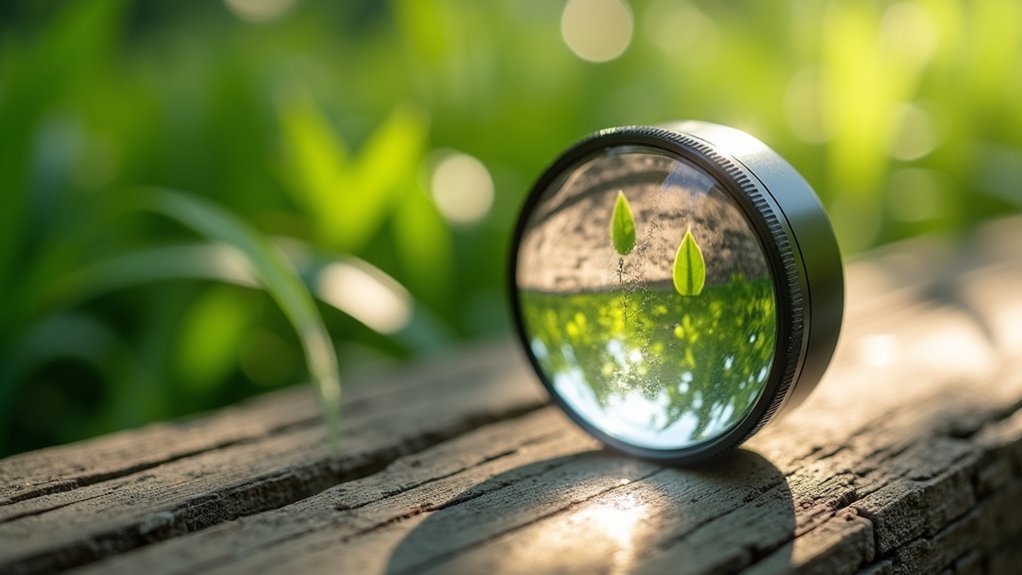
Environmental factors can greatly compromise your lens performance, with dust particles and debris creating unwanted artifacts that become more pronounced at certain working distances.
Temperature fluctuations will cause focus shifts as lens elements expand or contract, requiring you to recalibrate your working distance for ideal clarity.
You’ll achieve the clearest results by controlling your lighting conditions, as different light sources affect contrast and color accuracy at various working distances.
Dust and Debris Impact
The presence of unwanted particles in your shooting environment can greatly affect your lens’s ability to capture clear images.
As your working distance increases, dust and debris between your lens and subject scatter light more considerably, degrading image quality. You’ll notice this especially in outdoor settings where environmental conditions are less controlled.
- Tiny particles creating a hazy veil across your frame
- Sharp details becoming softened as light diffracts around debris
- Contrast reduction as scattered light spreads across the sensor
- Previously crisp edges appearing fuzzy at longer distances
- Bright light sources developing unwanted flares and halos
To maintain ideal lens performance, clean your equipment regularly and consider protective coatings.
Working at appropriate distances for your specific lens while minimizing environmental contaminants will help guarantee the sharpest, clearest images possible.
Temperature-Induced Focus Shifts
As temperatures fluctuate during your shoot, subtle yet significant changes occur within your lens elements that directly impact ideal working distances.
When temperatures rise, materials within your lens expand, potentially shifting your focus point and compromising your ability to focus on near subjects with precision.
Glass lenses are particularly susceptible to temperature-induced changes, while plastic varieties demonstrate greater stability.
You’ll notice these effects most dramatically when altering between environments—moving from air-conditioned interiors to hot outdoor settings can temporarily degrade image sharpness until your equipment stabilizes.
To maintain the best working distances in varying conditions, regularly calibrate your equipment and allow your lenses time to acclimate before critical shoots.
Testing your gear across different temperature ranges will help you anticipate necessary adjustments to maintain consistent focus accuracy.
Lighting Conditions Matter
When working with even the finest lenses, lighting conditions dramatically influence your ability to achieve ideal focus at recommended working distances.
Natural light provides the most reliable environment for lens testing, offering consistent illumination that helps you accurately assess sharpness and clarity.
- Bright, diffused daylight reveals true lens performance without the distortion poor lighting introduces.
- Fluorescent lighting can mask focus issues and create misleading results.
- Stationary subjects eliminate variables that compound in challenging lighting situations.
- Higher humidity and poor air quality degrade light transmission, affecting your visual comfort.
- Even distribution of light across your subject helps prevent hotspots that mislead your focus assessment.
Proper lighting doesn’t just improve image quality—it extends effective working distance by minimizing atmospheric interference that would otherwise limit lens performance.
Specialized Working Distances for Biological Specimens
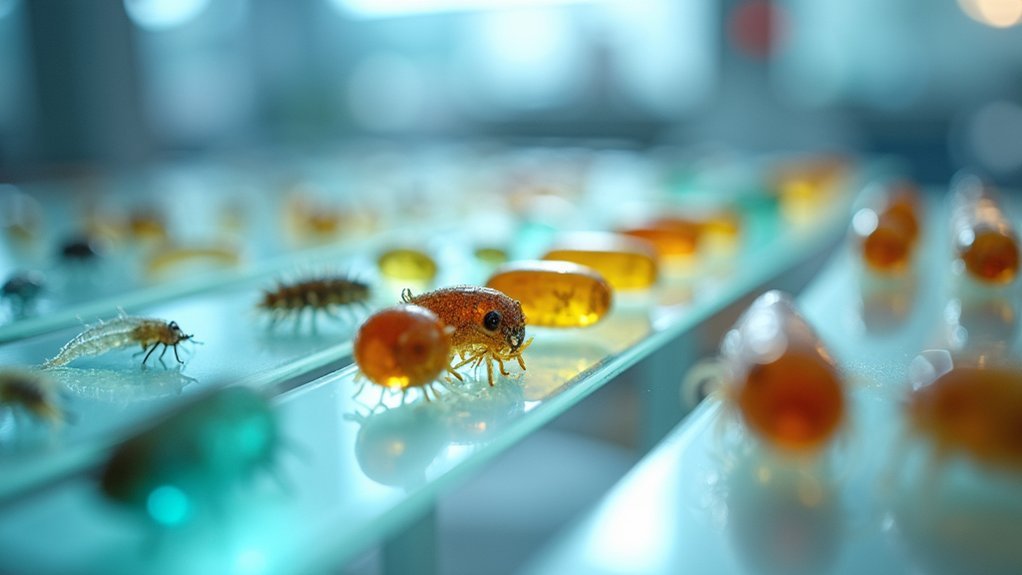
Biological specimens require carefully calibrated working distances to guarantee ideal visibility and manipulation under the microscope. When you’re working with biological samples, you’ll encounter working distances ranging from 0.1 mm to several centimeters, depending on your specimen size and required magnification.
Low-power objectives, like 4x lenses, offer generous working distances around 24 mm, giving you ample space to manipulate and orient your specimens. In contrast, high magnification lenses such as 100x oil immersion objectives dramatically reduce this distance to approximately 0.2 mm, demanding precise focusing techniques.
The working distance you select critically impacts both image clarity and your ability to work with the specimen. Choosing the appropriate distance guarantees maximum resolution and visibility of fine details while maintaining enough space for effective specimen handling.
Adjusting Working Distance for Different Mounting Media
When adjusting your lens’s working distance for different mounting media, you’ll need to take into account the medium’s viscosity, which affects light transmission and focusing precision.
You’ll also want to factor in the refractive index of your mounting medium, as this can greatly alter how light travels through the specimen to your lens.
Don’t forget to make appropriate adjustments for coverslip thickness, as even slight variations can impact image clarity and resolution at your best working distance.
Medium Viscosity Matters
Although often overlooked, the viscosity of mounting media plays a critical role in determining ideal lens performance. When you’re working with different mounting media, you’ll need to adjust your working distance to compensate for changes in refractive index that medium viscosity introduces.
- Thicker mounting media bend light differently, requiring you to recalibrate your working distance.
- Higher viscosity substances can introduce aberrations that compromise image clarity.
- Each lens design has a suitable viscosity-to-distance ratio for peak performance.
- Without proper adjustment, even premium lenses will produce subpar results.
- Your focus accuracy directly correlates with how well you’ve accounted for the medium’s properties.
Refractive Index Considerations
Understanding refractive indices forms the cornerstone of proper lens adjustment across different mounting media.
When you shift your lens from air (refractive index ≈1.0) to water (refractive index ≈1.33), you’ll need to recalculate your working distance to maintain focus quality.
The higher refractive index of water bends light more markedly than air does, shifting the focal point and requiring adjustments to preserve image sharpness.
Without these calculations, you’ll encounter focus errors that compromise your results.
For ideal lens performance, always factor in the mounting medium’s refractive index.
This becomes especially critical in specialized applications like underwater photography or when using optical instruments in various environments.
Coverslip Thickness Adjustments
Since coverslip thickness directly impacts your working distance, making appropriate adjustments is essential for excellent lens performance.
When switching between different mounting media, you’ll need to recalibrate your microscope to maintain ideal focal length and image clarity.
- Standard #1.5 coverslips (0.17mm) provide consistent working distance for most applications
- Thicker coverslips decrease effective working distance by lengthening the optical path
- Thinner coverslips increase working distance but may introduce distortion
- Different mounting media with varying refractive indices require specific coverslip thickness combinations
- Proper calibration prevents focus drift and maintains resolution when changing coverslip types
Remember that the relationship between coverslip thickness and working distance isn’t just about physical measurements—it’s about maintaining the precise focal length your objectives were designed to achieve with specific mounting conditions.
Working Distance Considerations for Stereomicroscopes
The appropriate working distance for stereomicroscopes plays a crucial role in their practical functionality, typically ranging from 50 mm to 100 mm. This space allows you to manipulate specimens easily while maintaining focus and image quality.
When working with larger or complex samples, you’ll benefit from longer working distances that provide unobstructed access to your specimen.
Keep in mind that magnification power affects your ideal working distance—lower magnifications generally permit greater distances than higher ones.
Be aware that adjusting working distance impacts depth of field; longer distances may create a shallower depth of field, potentially limiting detail visibility.
For the best image quality and resolution, you’ll need to properly align both the optics and specimen at the recommended working distance. This alignment guarantees crisp, clear observations throughout your microscopy work.
The Impact of Coverslip Thickness on Effective Working Distance
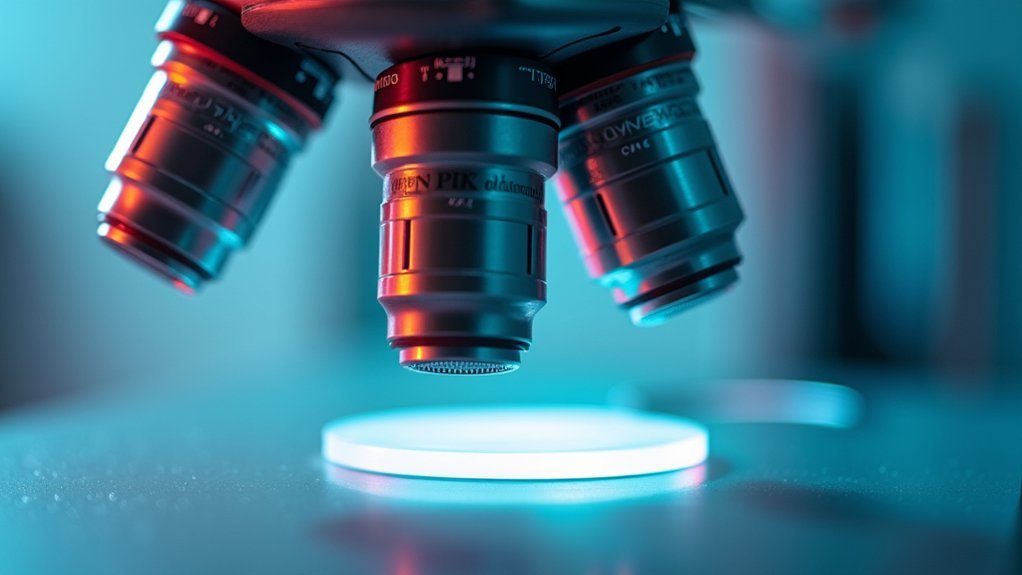
When selecting coverslips for your microscopy work, their thickness greatly influences your lens’s effective working distance. The standard 0.17 mm thickness is tailored for most lens designs, creating an ideal path for light to travel through your specimen.
When coverslip thickness varies from specifications, you’ll notice:
- Shifted focal points requiring working distance adjustments
- Decreased image clarity, especially at high magnifications
- Compromised resolution in oil immersion objectives
- Inaccurate measurements of specimen structures
- Potential damage to objectives if working distance becomes too short
Understanding this relationship is critical for proper lens function.
If you’re using specialized objectives, particularly for high-resolution imaging, always verify the recommended coverslip specifications. Modern lens design accounts for these variables, but you’ll still need to match coverslip thickness to your objective’s requirements for peak results.
Frequently Asked Questions
Which Lens Has the Greatest Working Distance?
The iD Screen lens has the greatest working distance of approximately 12 feet, while the iD Zoom only reaches about 8 feet. You’ll find the Screen better for activities requiring vision at varying distances.
At What Distance Should Reading Glasses Work?
Your reading glasses should work ideally at a distance of 11 to 16 inches from your eyes. This range allows you to maintain comfortable posture and reduce eye strain while reading or performing close-up tasks.
What Is the Working Distance for a Lens?
The working distance for a lens is the ideal range where you’ll see clearly. It’s the minimum and maximum focal lengths where your lens performs best for your specific visual tasks.
What Distance Is a 300MM Lens Good For?
A 300mm lens is great for you at distances between 15-30 feet. You’ll get excellent results photographing wildlife, sports, and portraits. It’s also effective at longer distances, creating beautiful background separation.
In Summary
You’ll find that choosing the right working distance greatly impacts your lens performance. Whether you’re using standard objectives or long-distance versions, always consider the trade-offs between magnification and clearance. Remember to account for coverslip thickness and mounting media when setting up your microscope. By mastering these working distance principles, you’ll capture clearer images and protect your valuable specimens and equipment.





Leave a Reply